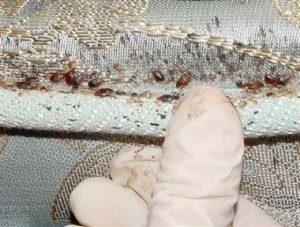“sleep tight, don’t let the bed bugs bite”
 Ever hear that old saying? It came about in the early days before box springs. One would support the mattress which at that time was usually straw, with criss crossed ropes and pulling the ropes ‘tight’ would keep it from sagging. This was believed to keep the bed bugs away however tight ropes didn’t stop the bed bugs and man has been struggling with them ever since.
Ever hear that old saying? It came about in the early days before box springs. One would support the mattress which at that time was usually straw, with criss crossed ropes and pulling the ropes ‘tight’ would keep it from sagging. This was believed to keep the bed bugs away however tight ropes didn’t stop the bed bugs and man has been struggling with them ever since.
Bed bugs are blood-sucking insects that feed at night. ‘ On you.’ Although they aren’t known to spread disease the  discomfort from their bites and the fear induced by the mere mention of their name is almost in epidemic proportions especially in the recent years. Bites usually only affect the surface and are small itchy red bumps. Sometimes they are found in a line or in clusters formation indicating multiple bites from the same hungry critter. Symptoms can vary and sometimes reactions can be much worse than described.
discomfort from their bites and the fear induced by the mere mention of their name is almost in epidemic proportions especially in the recent years. Bites usually only affect the surface and are small itchy red bumps. Sometimes they are found in a line or in clusters formation indicating multiple bites from the same hungry critter. Symptoms can vary and sometimes reactions can be much worse than described.
Living in mattresses, bedding, picture frames, cracks and crevices they are a formidable foe. Infestations are usually spread by a persons travel. Bed bugs ‘hitch’ rides in a persons luggage and come out in the dark hours of the night to feed. Hotels are especially vulnerable since different travelers use the rooms almost every night. Eventually that traveler comes home and not so long after, their home is infested with bed bugs and they need help.
Inspect first
 Treating for bed bugsis no easy task. Your greatest asset will be your thoroughness. First start by inspecting. Generally speaking bed bugs won’t infest your entire home so it’s best to start from your bedroom areas and work out from there. Bedbugs are small reddish brown flat bodied insects. Fecal matter is usually visible in infested areas as small dark red spots as well as small sloughed off skin castes. Able to hide in cracks as thin as a credit card use a bright flashlight and look on, under and behind everything possible. Check every crack or crevice, bed posts, mattress seams, buttons, frame work, headboard (classic spot so pull that headboard out for close examination and treatment ). Don’t stop there! Check behind all your pictures, around your window frames and in the curtains (including curtain rods), any dressers or desks. Closets should be looked at especially if that’s where you keep your empty suit cases. As you move out to other areas take notes of where you’ve spotted the bugs or place small markers so you don’t forget. Missing any area can hinder your efforts greatly. Bed bugs can travel up to 100 feet away but usually don’t stray to far from their source of food. Basically no area is above suspicion and seeing where to treat before you break out the spray can will be your best bet for quick relief.
Treating for bed bugsis no easy task. Your greatest asset will be your thoroughness. First start by inspecting. Generally speaking bed bugs won’t infest your entire home so it’s best to start from your bedroom areas and work out from there. Bedbugs are small reddish brown flat bodied insects. Fecal matter is usually visible in infested areas as small dark red spots as well as small sloughed off skin castes. Able to hide in cracks as thin as a credit card use a bright flashlight and look on, under and behind everything possible. Check every crack or crevice, bed posts, mattress seams, buttons, frame work, headboard (classic spot so pull that headboard out for close examination and treatment ). Don’t stop there! Check behind all your pictures, around your window frames and in the curtains (including curtain rods), any dressers or desks. Closets should be looked at especially if that’s where you keep your empty suit cases. As you move out to other areas take notes of where you’ve spotted the bugs or place small markers so you don’t forget. Missing any area can hinder your efforts greatly. Bed bugs can travel up to 100 feet away but usually don’t stray to far from their source of food. Basically no area is above suspicion and seeing where to treat before you break out the spray can will be your best bet for quick relief.
Be thorough
In treating for bed bugs you want to be no less thorough. There are aerosols, dusts and liquid residual insecticides that are available and labeled for use to treat bed bugs. Powders, concentrates, aerosols,traps etc.. Please read the labels of these products so you’ll know which ones are best for you and where to use them.
Retreating for bed bugs is very common and sometimes as much as three or four applications is needed to eradicate this fearsome pest.
Consider professional help
If all this seems to much or you’re not quite sure of how to handle pest control products then perhaps it’d be better to call in a  professional. It can very expensiveve but they know their work and usually back up the treatment with service guarantees. Eggs can be laid just about anywhere and nothing sprayed will stop them from hatching and even missing a few means you’ll be retreating later. It is often recommended to throw out your mattress if it is infested because of the risk of putting insecticides on a surface you’ll be spending time on. Heat treatments for bed bugs can eliminate this and there are even bed bug proof covers available now which may save your favorite mattress from the dumpster. Your local pro should be able to help you or you can consider the other alternative. In any event get ready for a fight and try your best to use common sense when applying chemicals.
professional. It can very expensiveve but they know their work and usually back up the treatment with service guarantees. Eggs can be laid just about anywhere and nothing sprayed will stop them from hatching and even missing a few means you’ll be retreating later. It is often recommended to throw out your mattress if it is infested because of the risk of putting insecticides on a surface you’ll be spending time on. Heat treatments for bed bugs can eliminate this and there are even bed bug proof covers available now which may save your favorite mattress from the dumpster. Your local pro should be able to help you or you can consider the other alternative. In any event get ready for a fight and try your best to use common sense when applying chemicals.




